Madlener House
4 West Burton Place
Chicago, Illinois 60610
Telephone: 312.787.4071
info@grahamfoundation.org
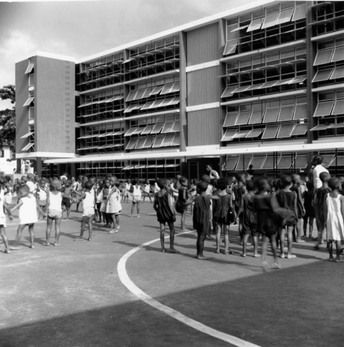
The creation of an African education curriculum and improved access to education have been central to the continent’s development goals from the dying days of colonization to the present. During Africa’s early independence era of the 1950’s and ‘60s, a significant number of school building projects were commissioned to respond to this need. This period of architectural production in Anglophone West Africa coincided with the constellation of a final tranche of colonial funds, international aid, and the presence of a cadre of young modernist architects, many of whom were affiliated with the Architectural Association’s Tropical School. Ola Uduku will explore the architecture, historic symbolism, and legacy of some of the most significant schools built during period and the architects and other actors who contributed to their design.
Ola Uduku is reader in architecture and Dean International for Africa at Edinburgh University’s School of Architecture and Landscape Architecture (ESALA). She received her PhD from the University of Cambridge, was Smutts Fellow in African Studies, and has lectured at Liverpool and Strathclyde Universities. Her research interests include: the history of educational architecture in Africa, gated communities, and issues surrounding social infrastructure provisions for minority communities in cities. In 2014 she completed the British Academy-funded Alan Vaughan Richards Archive Project. Currently she is involved in the Conserving West African Modernism Project (with KNUST, Kumasi) and is founding member of ArchiAfrika, a non-profit dedicated to improving architectural education and knowledge of architectural history in Africa. She is also a member of Docomomo International and is supporting Ghana’s membership application. Her publications include chapters and articles in Architecture Beyond Europe (2015); Radical Pedagogies Project (2015); and Designing Schools: Space, Place and Pedagogy in the Twentieth Century (Taylor and Francis, forthcoming), among others.
Image: Fry and Drew, CMS Primary School Lagos, c.1950s. From the exhibition AA in Africa, Architectural Association School of Architecture, London, 2002.
For more information on the exhibition, Architecture of Independence: African Modernism, click here.
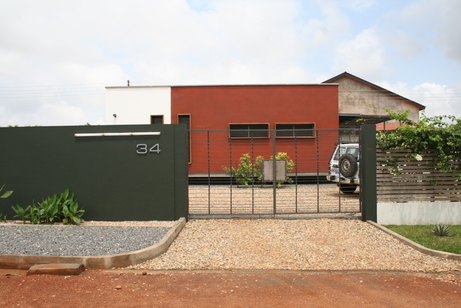
In 2004, architect, academic, and novelist Lesley Lokko made the decision to build her own house in Accra, Ghana, where she grew up. In an era where middle-class Ghanaian aspirations tend firmly towards neo-Classicism, Lokko’s “Miesian mud house” provoked much criticism. ‘Is it a petrol station?’, one passer-by asked indignantly, referring to the white, square Shell petrol stations, first introduced in Accra in the early 1960s, few of which are still standing in their original state. In conjunction with the Graham Foundation’s new exhibition, Architecture of Independence: African Modernism, Lokko will explore the relationship between form, memory, identity, and independence.
Lesley Lokko is head of the Postgraduate School of Architecture at the University of Johannesburg and the author of nine best-selling novels. She received her BSc(Arch) and MArch from the Bartlett School of Architecture, University College London, and her PhD in architecture from the University of London. She has taught at schools of architecture in the US, the UK, as well as South Africa, where she was Visiting African Scholar at the University of Cape Town. She is the editor of "White Papers, Black Marks: Race, Culture, Architecture" (University of Minnesota Press, 2000) and has been an on-going contributor to discourses around identity, ‘race’, African urbanism and the speculative nature of African architectural space for almost twenty years.
Image: House Lokko. Completed July 2005, Accra, Ghana. Photo by Lesley Lokko.
For more information on the exhibition, Architecture of Independence: African Modernism, click here.
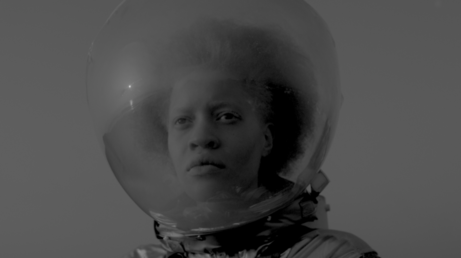
Join us on Thursday, March 17 for a special screening of the short film, Afronauts, with director Frances Bodomo and film scholar Jacqueline Stewart. Based on true events, Afronauts tells the story of the short-lived Zambian space program and its attempts to join the space race in the late 1960s. Afronauts is Bodomo's second short film and premiered at Sundance Film Festival in 2014. (Total runtime: 14 minutes)
Frances Bodomo is an award-winning Ghanaian filmmaker who grew up in Ghana, Norway, California, and Hong Kong before moving to New York City to study film at Columbia University (BA) and the Tisch School of the Arts (MFA). Her first short film, Boneshaker (starring Oscar-nominee Quvenzhané Wallis), premiered at the 2013 Sundance Film Festival and played at over 20 film festivals. Bodomo was named a 2015 Sundance Institute/Alfred P. Sloan Fellow and aspires to make conceptually strong films that bring African images to the forefront.
Jacqueline Stewart is a professor in the Department of Cinema and Media Studies at the University of Chicago. She is the author of Migrating to the Movies: Cinema and Black Urban Modernity (University of California Press, 2005). Her essays have appeared in Critical Inquiry, Film Quarterly, Film History, and The Moving Image. She is completing a study of African American actor, writer, and director Spencer Williams. She is co-curator of the L.A. Rebellion project at the UCLA Film and Television Archive. Her film work in Chicago includes founding the South Side Home Movie Project and serving as Curator of Black Cinema House, a neighborhood-based film exhibition venue run by Theaster Gates’ Rebuild Foundation.
This event is presented in conjunction with the Graham Foundation's current exhibition Architecture of Independence: African Modernism, on view through April 16.
To view the trailer for Afronauts, click here.
Image: Diandra Forrest as Matha. Afronauts. Dir Frances Bodomo, 2014.
For more information on the exhibition, Architecture of Independence: African Modernism, click here.
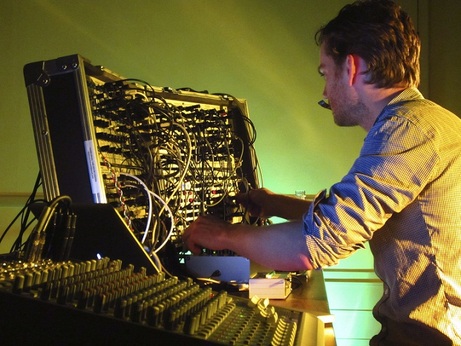
Dutch artist Thomas Ankersmit will premiere new work commissioned by Lampo—a composition for analog Serge modular and digital oscillators that combines a blizzard of microsounds with sculptural fields of pure tone. This project is Ankersmit's first significant foray into the digital realm and first fully quadraphonic composition.
Thomas Ankersmit is a composer, musician and installation artist based in Berlin and Amsterdam. Acoustic phenomena such as sound reflections, infrasonic vibration, otoacoustic emissions, and highly directional projections of sound have been an important part of his work since the early 2000s. His music is also characterized by a deliberate misuse of equipment, using feedback and disruptions to the signal, and the extremes of frequency and dynamics, to create visceral but finely detailed swarms of sound. Since 2006 his main instrument, both live and in the studio, has been the Serge analogue modular synthesizer. His recent collaborations include a series of electroacoustic pieces with Sicilian composer and performer Valerio Tricoli; recording sessions with Kevin Drumm at GRM in Paris; and a new Phill Niblock composition for Serge modular synthesizer (Niblock’s first piece for an electronic instrument). Ankersmit has performed twice before in the Lampo series—in February 2012 and September 2008.
Commissioned by Lampo with the support of the Performing Arts Fund NL. This performance is presented in partnership with Lampo. Founded in 1997, Lampo is a non-profit organization for experimental music and intermedia projects.
Please Note: Seating for this performance is very limited. RSVP is required and event entry is first-come, first-serve, so please plan to arrive early. Doors will open at 7:30pm.
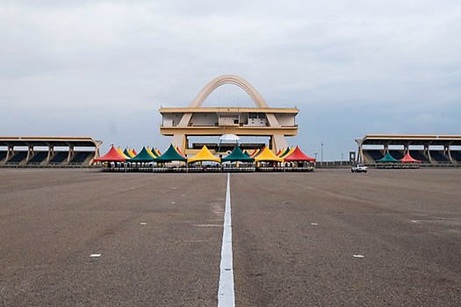
In 2008, Mabel Wilson and Peter Tolkin traveled through Ghana, documenting the architecture that had been erected during the 1950's and 1960's in the decades following the end of European colonial rule.These mid-century buildings were mostly modernist, designed by architects from Australia, the United Kingdom, the United States, Lebanon, Italy and Ghana; they had been reviewed in contemporary architectural publications, as part of a lively debate on what became known as “tropical modernism.” Until recently, the legacy of these mid-century buildings had all but disappeared from the western historical canon; and with their absence we've failed to understand how critical the African continent was to the discourse of modernism. In this talk, Wilson and Tolkin will discuss their project, examining how these buildings have fared in the half-century since their construction and how they function in today's increasingly urban and global contexts.
Mabel O. Wilson is an award-winning designer and scholar. She received a doctorate in American Studies from NYU and an MArch from Columbia’s Graduate School of Architecture, Planning and Preservation. As the Nancy and George E. Rupp Professor at Columbia University's GSAPP, she directs the program for Advanced Architectural Research, co-directs the Global Africa Lab, and is a Senior Fellow at the Institute for Research in African American Studies in GSAS. Her collaborative design practices (KW: a and Studio &) have worked on speculative and built projects. Wilson's scholarly research investigates space and cultural memory in black America, race and visual culture, and new technologies and the social production of space. Her essays have appeared in numerous journals and books on critical geography, cultural memory, visual culture, and architecture. Wilson's recent book, Negro Building – Black Americans and the World of Fairs and Museums, studies how the spaces of world’s fairs, emancipation expositions, and grassroots public museums became sites to imagine Afro-modernity.
Peter Tolkin is the founding principal of Peter Tolkin Architecture. Influenced by his formal education with renowned American artists Allan Sekula and Lewis Baltz and subsequent work as a documentary photographer, his practice speaks to the social and cultural context of a project. With a natural curiosity in the contingencies that impact the conditions of contemporary culture, Tolkin’s seminal explorations as an artist provided the conceptual kernel for an architectural practice that interprets contextual narratives. He received a BA in Art and Art History from the University of California, Santa Cruz, a MFA in Photography from the California Institute of the Arts, and a MArch from Columbia University. Tolkin continues to practice photography as a complement to his architectural work.
Image: Black Star Square, also know as Independence Square, was built to commemorate independence from colonial rule. Accra, Ghana, 1961.
Unless otherwise noted,
all events take place at:
Madlener House4 West Burton Place, Chicago
GALLERY AND BOOKSHOP HOURS
2025 Chicago Architecture Biennial
SHIFT: Architecture in Times of Radical Change
Sep 19, 2025–Feb 28, 2026
Wed–Sat, 12–5 p.m.
To make an appointment, email: bookshop@grahamfoundation.org
CONTACT
312.787.4071
info@grahamfoundation.org
Accessibility
Events are held in the ballroom on the third floor which is only accessible by stairs.The first floor of the Madlener House is accessible via an outdoor lift. Please call 312.787.4071 to make arrangements.
Copyright © 2008–2025 Graham Foundation. All rights reserved.
 PREVIOUS POSTS
PREVIOUS POSTS